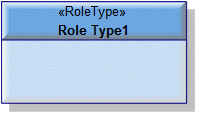Role type (UPDM - MODAF aliases)

Creation
To create a Role Type:
• From an Architectural Description or Service Description: right-click the Architectural Description or Service Description, point to New, point to MODAF, point to Operational, and then click Role Type.
• From a Role Type: right-click the Role Type, point to New, point to MODAF, and then click Role Type.
• From an OV-4 Typical Organizational Relationships Chart, SV-1 Resource Definition, SV-4 Functionality Hierarchy, SV-5 Function to Operational Activity/Service Function Definition or SV-9 Technology and Skills Forecast Definition: click the  Role Type button, and then click in free space on the diagram.
Role Type button, and then click in free space on the diagram.
 Role Type button, and then click in free space on the diagram.
Role Type button, and then click in free space on the diagram.Appearance
When shown on an OV-4 Typical Organizational Relationships Chart, SV-1 Resource Definition, SV-4 Functionality Hierarchy, SV-5 Function to Operational Activity/Service Function Definition or SV-9 Technology and Skills Forecast Definition, a Role Type appears as follows:

When shown on an SV-1 Resource Interaction Specification or SV-2 Resource Communications Description, a Role Type appears as follows:

Relationships
The following relationships are of importance to a Role Type:
• UML Generalizations define Role Type inheritance ( SV-1 Resource Definition).
• Forecast relationships link a Role Type to forecasted future Role Type elements.
• Is Capable Of Performing relationships to link a Role Type to the Function elements that can be performed by the Role Type.
• Requires Competence and Typically Provides Competence relationships link the Role Type to the Competence elements that are required or provided by that Role Type.
• Used as a conveyed classifier for Operational Exchange elements.
The following sections provide information about how a Role Type is used in the model.
Create a Role Type from
Create from a Role Type
In addition to the UPDM elements that can be created from all UPDM elements (Alias, Definition, Information and Metadata):
Shown on these diagrams, tables and matrices
In addition to the AV-2 Integrated Dictionary and TV-1 Standards Profile, which can show all UPDM elements:
UPDM writeable properties
The following writeable properties are available on the Role Type tab of a Role Type element's Property Pages:
• isEncapsulated
• URI
































